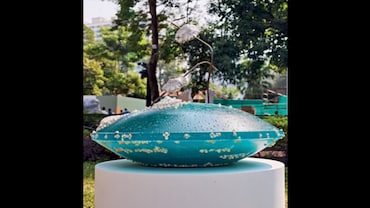- HOME
- /
- Culturescape
- /
- Studio
- /
The Human Figure In Arpita Singh's Compositions
Central to Arpita Singh’s compositions, the human figure is never fleshed out—wrinkled and bony, it appears as a witness to the maladies of its time.
 Whatever is Here, by Arpita Singh, Oil on canvas, 84 x 108 inches, 2006 (Photo courtesy Kiran Nadar Museum of Art)
Whatever is Here, by Arpita Singh, Oil on canvas, 84 x 108 inches, 2006 (Photo courtesy Kiran Nadar Museum of Art)
Central to Arpita Singh’s compositions, the human figure is never fleshed out—wrinkled and bony, it appears as a witness to the maladies of its time. In the triptych Whatever is Here, Dhritarashtra is seated at the centre, while his advisor and charioteer Sanjaya watches the battle through his binoculars. The war is everywhere—perhaps even eternal—with wise men helpless. The title borrows from these lines in the Mahabharata: “Whatever is here, is found elsewhere. Whatever is not here, is nowhere else.” The vibrant hues, the use of text and objects such as aeroplanes and guns make it seem like a child’s perspective of the incorrigible world of adults.
Do You Like This Story?
1
0






